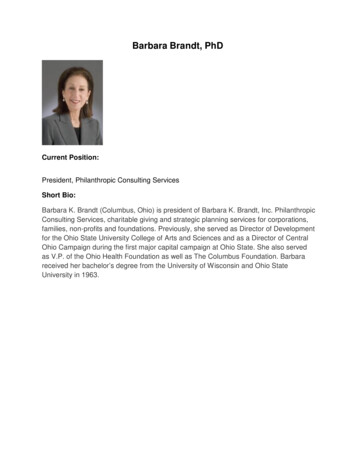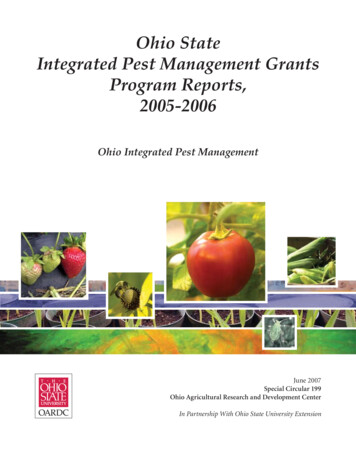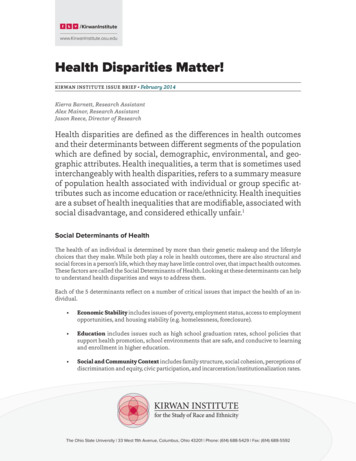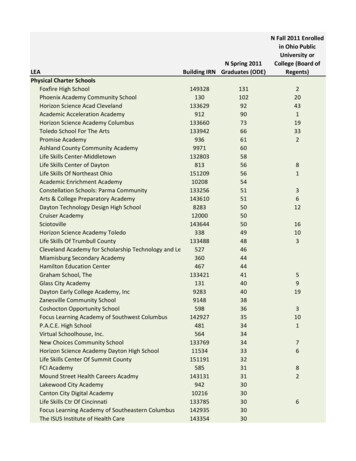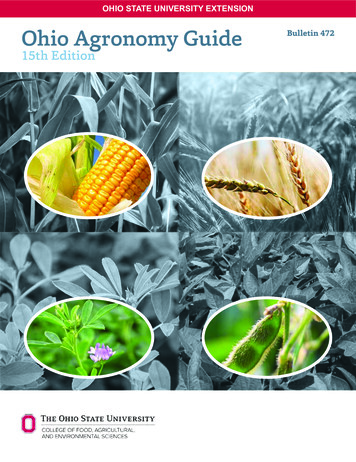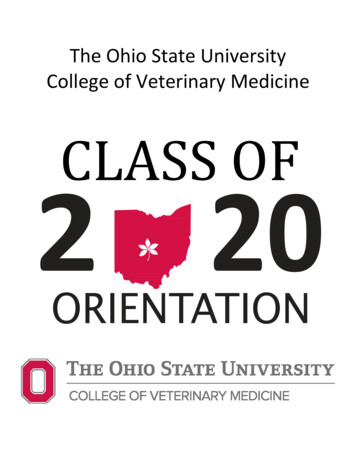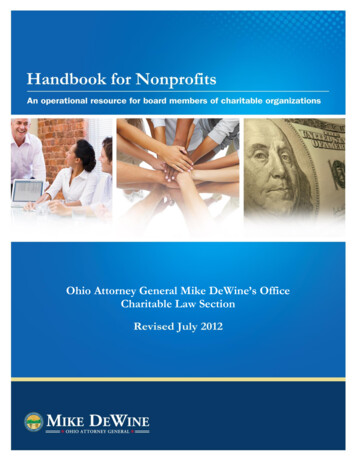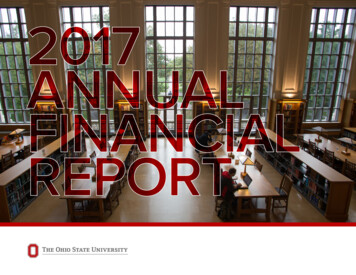
Transcription
2017ANNUALFINANCIALREPORT
2017 Financial Report The Ohio State UniversityCONTENTSMessage from the President and interim CFO3Report of Independent Auditors6Management’s Discussion and Analysis8Statements of Net Position20Statements of Revenues, Expensesand Other Changes in Net Position21Statements of Cash Flows22Notes to the Financial Statements24Required Supplementary Informationon GASB 68 Pension Liabilities68Supplementary Information on theLong-Term Investment Pool69Acknowledgments71Board of Trustees722
2017 Financial Report The Ohio State UniversityMessage from the President and interim CFOOhio State’s momentum has never been greater.Several of our most important indicators are at historichighs and accelerating: applications, graduation rates,academic excellence, diversity, donor support, patientcare and the financial standing of our Wexner MedicalCenter. Now, we have unprecedented opportunity forfurther transformational growth.Dr. Michael V. Drake, PresidentOur strategic plan, launched this year, sets forth keyareas of investment that will define the flagship publicresearch university of the 21st century — and ourprogress is significant.The university’sstrategic plan,Time and Change,has five pillars:1TEACHING &LEARNING2ACCESS, AFFORDABILITY& EXCELLENCE3RESEARCH & CREATIVEEXPRESSION4ACADEMICHEALTH CARE5OPERATIONALEXCELLENCE &RESOURCE STEWARDSHIPREAD MOREGO.OSU.EDU/STRATEGICPLANMichael Papadakis,Interim Senior Vice Presidentand CFO, and Treasurer3
2017 Financial Report The Ohio State UniversityExamples include:Tuition guaranteeThe new Ohio State Tuition Guarantee offers incoming studentscertainty about the cost of a college education by setting rates for instate tuition, mandatory fees, room and board that will be frozen for fouryears.Tuition coverageStarting in fall 2018, the university will expand financial aid packages toprovide thousands of in-state students whose families are at or belowthe median income of the state with funding that covers the full cost oftuition and mandatory fees on the Columbus campus.Expanded financial aidAdministrative efficiencies have funded 60 million in President’sAffordability Grants over three years; and other strategic institutionalfunds are supporting the expansion of the Land-Grant OpportunityScholars program to cover the full cost of admission.Innovative fundingOhio State entered into a comprehensive energy managementpartnership that is providing 1.165 billion in resources for our academicmission, launching an energy-efficiency campaign and creatingopportunities in energy and sustainability research.Digital Flagship UniversityThrough a comprehensive, university-wide digital learning initiative,Ohio State will collaborate with Apple to support educational innovationfor students and economic development opportunities for thecommunity. Starting in fall 2018, Ohio State will provide each incomingfirst-year student with an iPad Pro learning-technology suite.Revenue SourcesFiscal 2017 University Budget(in millions)Tuition 927State appropriations541Grants and contracts812Patient care3,341Sales and services509Gifts260Net investment income601Total Revenues 6,991INVESTMENT 1.165 LARGESTin university’s missionBILLIONCommitment to:improvement in%ENERGY EFFICIENCY10yrs10within 50 MILLIONINNOVATION CENTER to be developedREAD MOREGO.OSU.EDU/CEMP4
2017 Financial Report The Ohio State UniversityPhilanthropic supportBuckeye Nation gave to Ohio State in record numbers in FY17, withmore than 267,000 donors contributing over 532 million, includinga cash total of 403 million. Fundraising activity increased almost 17percent from the previous record-setting year.Campus of the futureProjects identified in Framework 2.0, a vision for the physical space ofthe Columbus campus, include: an interdisciplinary research facility;an arts district that opens the university’s front door to the heart of thecommunity; an interdisciplinary health sciences center; and best-ofclass hospital and ambulatory facilities at the Wexner Medical Center.What Ohio State does matters. We will continue to demonstrate anew model in higher education, uplifting the students, families andcommunities that our university serves.Sincerely,The university’s physical plan for campus,called Framework 2.0, has four goals:1 PROMOTE STUDENT SUCCESS2 SUPPORTACADEMIC, RESEARCH AND OUTREACH MISSION 3 STRENGTHEN ACCESS AND CONNECTIVITY4 TRANSFORM NATURAL SYSTEMS AND OPEN SPACEMichael V. Drake, MDPresidentREAD MOREGO.OSU.EDU/FRAMEWORKMichael PapadakisInterim Senior Vice President and CFO, and Treasurer5
Report ofIndependentAuditorsReport of Independent AuditorsTo the Board of Trustees ofThe Ohio State UniversityColumbus, Ohio:We have audited the financial statements of the primary institution and of the aggregate discretelypresented component units, which collectively comprise The Ohio State University (the “University”),appearing on pages 20 to 23, which consist of the statements of net position as of June 30, 2017 and June30, 2016, the related statements of revenues, expenses and other changes in net position and of cashflows for the years then ended, and the related notes to the financial statements, which collectivelycomprise the University’s basic financial statements. The University is a component unit of the State ofOhio.Management’s Responsibility for the Financial StatementsManagement is responsible for the preparation and fair presentation of the financial statements inaccordance with accounting principles generally accepted in the United States of America; this includesthe design, implementation, and maintenance of internal control relevant to the preparation and fairpresentation of financial statements that are free from material misstatement, whether due to fraud orerror.Auditors’ ResponsibilityOur responsibility is to express opinions on the financial statements based on our audits. We conductedour audits in accordance with auditing standards generally accepted in the United States of America.Those standards require that we plan and perform the audit to obtain reasonable assurance about whetherthe financial statements are free from material misstatement.An audit involves performing procedures to obtain audit evidence about the amounts and disclosures inthe financial statements. The procedures selected depend on our judgment, including the assessment ofthe risks of material misstatement of the financial statements, whether due to fraud or error. In makingthose risk assessments, we consider internal control relevant to the University's preparation and fairpresentation of the financial statements in order to design audit procedures that are appropriate in thecircumstances, but not for the purpose of expressing an opinion on the effectiveness of the University'sinternal control. Accordingly, we express no such opinion. An audit also includes evaluating theappropriateness of accounting policies used and the reasonableness of significant accounting estimatesmade by management, as well as evaluating the overall presentation of the financial statements. Webelieve that the audit evidence we have obtained is sufficient and appropriate to provide a basis for ouraudit opinions.PricewaterhouseCoopers LLP, 41 South High Street, Suite 2500, Columbus, OH 43215T: (614) 225 8700, F: (614) 224 1044, www.pwc.com/us6
Report ofIndependentAuditorsOpinionsIn our opinion, the financial statements referred to above present fairly, in all material respects, therespective financial position of the primary institution and the aggregate discretely presented componentunits of the University as of June 30, 2017 and June 30, 2016, and the respective changes in financialposition and cash flows thereof for the years then ended in accordance with accounting principlesgenerally accepted in the United States of America.Other MattersRequired Supplementary InformationThe accompanying management’s discussion and analysis on pages 8 through 19, and the RequiredSupplementary Information on GASB 68 Pension Liabilities on page 68 are required by accountingprinciples generally accepted in the United States of America to supplement the basic financial statements.Such information, although not a part of the basic financial statements, is required by the GovernmentalAccounting Standards Board who considers it to be an essential part of financial reporting for placing thebasic financial statements in an appropriate operational, economic, or historical context. We have appliedcertain limited procedures to the required supplementary information in accordance with auditingstandards generally accepted in the United States of America, which consisted of inquiries of managementabout the methods of preparing the information and comparing the information for consistency withmanagement's responses to our inquiries, the basic financial statements, and other knowledge weobtained during our audits of the basic financial statements. We do not express an opinion or provide anyassurance on the information because the limited procedures do not provide us with sufficient evidence toexpress an opinion or provide any assurance.Other InformationOur audits were conducted for the purpose of forming opinions on the financial statements thatcollectively comprise the University’s basic financial statements. The accompanying other information onthe long-term investment pool on pages 69 through 70 is presented for purposes of additional analysis andis not a required part of the basic financial statements. Such information has not been subjected to theauditing procedures applied in the audit of the basic financial statements and, accordingly, we do notexpress an opinion or provide any assurance on it.November 6, 201727
2017 Financial Report The Ohio State UniversityManagement’s Discussion and AnalysisAbout The Ohio State UniversityThe followingManagement’sDiscussion andAnalysis, or MD&A,provides an overviewof the financial positionand activities of TheOhio State University(the “university”)for the year endedJune 30, 2017,with comparativeinformation for theyears ended June 30,2016 and June 30,2015. We encourageyou to read thisMD&A section inconjunction withthe audited financialstatements andfootnotes appearingin this report.The Ohio State University is the State ofOhio’s flagship research institution and oneof the largest universities in the United Statesof America, with over 66,000 students,7,000 faculty members and 25,000 staffmembers. Founded in 1870 under the MorrillLand Grant Act, the university – which wasoriginally known as the Ohio Agriculturaland Mechanical College – has grown overthe years into a comprehensive publicinstitution of higher learning, with over 200undergraduate majors, 157 master’s degreeprograms, 121 doctoral programs and sevenprofessional degree programs.The Ohio State University Wexner MedicalCenter is one of the largest and most diverseacademic medical centers in the countryand the only academic medical center incentral Ohio. As a part of the Wexner MedicalCenter, the Health System operates underthe governance of The Ohio State UniversityBoard of Trustees and is comprised of sevenhospitals and a network of ambulatory carelocations. The Health System provides careacross the spectrum from primary care toquaternary specialized care. Key clinical carelocations and facilities at the Health Systeminclude: University Hospital: the MedicalCenter’s full-service tertiarycare facility that provides care topatients throughout the region.Year ended June 30, 2017 (unaudited) The Ohio State University Arthur G. James Cancer Hospital andSolove Research Institute: one of only41 National Cancer Institute-designatedComprehensive Cancer Centers.In fiscal 2015, the Arthur G. JamesCancer Hospital and Solove ResearchInstitute opened a new tower, which isa transformational facility that fosterscollaboration and integration of cancerresearch and clinical cancer care. Richard M. Ross Heart Hospital:The Ross is home to OSU’s Heart andVascular program, ranked 26th outof nearly 5,000 hospitals around thecountry by US News and World Report. OSU Harding Hospital: providesthe most comprehensive behavioralhealthcare services in central Ohio. University Hospital East: a fullservice community hospital. Dodd Hall: a 60-bed inpatientrehabilitation facility. Brain and Spine Hospital: providescomprehensive neuroscience careto improve prevention, detection andtreatment of brain and spine disorders. Ambulatory Services: a networkof community-based primary andsub-specialty care facilities.The Health System provided services toapproximately 61,700 adult inpatients and1,764,000 outpatients during fiscal year2017, 59,300 adult inpatients and 1,724,000outpatients during fiscal year 2016, and58,200 adult inpatients and 1,664,000outpatients during fiscal year 2015.The university is governed by a board oftrustees who are responsible for oversightof academic programs, budgets, generaladministration, and employment of facultyand staff. The university’s 15 colleges, fourregional campuses, the Wexner MedicalCenter and various academic support unitsoperate largely on a decentralized basis.The Board approves annual budgets foruniversity operations, but these budgetsare managed at the college anddepartment level.The following financial statements reflect allassets, liabilities, deferred inflows/outflowsand net position (equity) of the university,the Ohio State University Wexner MedicalCenter, the Ohio Agricultural Research andDevelopment Center (OARDC) and the OhioTechnology Consortium (OH-TECH), whichis an umbrella organization that includesthe Ohio Academic Resources Network(OARnet), the Ohio Supercomputer Centerand the Ohio Library and InformationNetwork (OhioLINK). These entitiesconstitute the “primary government” forfinancial reporting purposes. In addition, the8
Management’s Discussion and Analysis2017 Financial Report The Ohio State Universityfinancial statements include consolidatedfinancial results for a number of “componentunits”, which are legally separate entitiesthat meet the financial accountability criteriaset forth in Governmental AccountingStandards Board (GASB) Statement No. 14,The Financial Reporting Entity, as amendedby GASB Statement No. 61, The FinancialReporting Entity: Omnibus and StatementNo. 80, Blending Requirements for CertainComponent Units—an amendment of GASBStatement No. 14. OSU Physicians, Inc. (the practice groupfor physician faculty members of theColleges of Medicine and Public Health)The following component units areconsidered to “exclusively benefit” theuniversity and are shown in a blendedpresentation with the primary government: Dental Faculty Practice Association(the practice group for faculty membersof the College of Dentistry) The OSU Foundation (a fundraisingfoundation operating exclusivelyfor the benefit of the university) OSU Health Plan (a non-profitorganization – formerly knownas OSU Managed Health CareSystems – that administersuniversity health care benefits) Oval Limited (captive insurer thatprovides medical malpractice coverageto university hospitals and physicians)The GASB has indicated that, under theamended consolidation standards, the“exclusive benefit” criterion for blending isnot met when a component unit providesservices to parties external to the primarygovernment. As a result, the universitypresents the following component units in adiscrete presentation: Campus Partners for CommunityUrban Redevelopment (a non-profitorganization participating in theredevelopment of neighborhoodsadjacent to the main Columbus campus) Transportation Research Center,Inc. (an automotive research andtesting facility in East Liberty, Ohio)Condensed financial information forboth blended and discretely presentedcomponent units is provided in the Notes tothe Financial Statements. The university isconsidered a component unit of the State ofOhio and is included in the State of Ohio’sComprehensive Annual Financial Report.About the Financial StatementsThe university presents its financialstatements in a “business type activity”format, in accordance with GASB StatementNo. 34, Basic Financial Statements – andManagement’s Discussion and Analysis– for State and Local Governments andGASB Statement No. 35, Basic FinancialStatements – and Management’s Discussionand Analysis – for Public Colleges andUniversities – an amendment of GASBStatement No. 34. In addition to this MD&Asection, the financial statements include aStatement of Net Position, a Statement ofRevenues, Expenses and Other Changes inNet Position, a Statement of Cash Flows andNotes to the Financial Statements. Separatecolumns are presented for the primaryinstitution (which includes the primarygovernment and the blended componentunits), discretely presented component unitsand the total university. Unless otherwisespecified, the amounts presented in thisMD&A are for the primary institution.The Statement of Net Position is theuniversity’s balance sheet. It reflects thetotal assets, deferred outflows, liabilities,deferred inflows and net position (equity)of the university as of June 30, 2017, withcomparative information as of June 30, 2016.Liabilities due within one year, and assetsavailable to pay those liabilities, are classifiedas current. Other assets and liabilitiesare classified as non-current. Investmentassets are carried at fair value. Capitalassets, which include the university’s land,buildings, improvements, and equipment,are shown net of accumulated depreciation.Net position is grouped in the followingcategories: Net investment in capital assets Restricted – Nonexpendable Restricted – Expendable UnrestrictedIn addition to assets, liabilities and netposition, the university’s balance sheetincludes deferred outflows of resourcesand deferred inflows of resources. Deferred9
Management’s Discussion and Analysis2017 Financial Report The Ohio State Universityoutflows are similar to assets and will berecognized as expense in future periods.Deferred inflows are similar to liabilities andwill be recognized as revenue (or reductionsof expense) in future periods.the university and other public institutionshave traditionally relied upon to fund currentoperations, including state instructionalsupport, current-use gifts and investmentincome.The Statement of Revenues, Expensesand Other Changes in Net Position is theuniversity’s income statement. It details hownet position has increased (or decreased)during the year ended June 30, 2017, withcomparative information for the year endedJune 30, 2016. Tuition revenue is shownnet of scholarship allowances, patientcare revenue is shown net of contractualallowances, charity care and bad debtexpense, depreciation is provided for capitalassets, and there are required subtotals fornet operating income (loss) and net income(loss) before capital contributions andadditions to permanent endowments.The Statement of Cash Flows details howcash has increased (or decreased) during theyear ended June 30, 2017, with comparativeinformation for the year ended June 30,2016. It breaks out the sources and uses ofuniversity cash into the following categories:It should be noted that the requiredsubtotal for net operating income or losswill generally reflect a “loss” for statesupported colleges and universities. Thisis primarily due to the way operating andnon-operating items are defined underGASB Statement No. 9, Reporting CashFlows of Proprietary and NonexpendableTrust Funds and Governmental Entities ThatUse Proprietary Fund Accounting. Operatingexpenses include virtually all universityexpenses, except for interest on long-termdebt. Operating revenues, however, excludecertain significant revenue streams that Operating activities Non-capital financing activities Capital financing activities Investing activitiesCash flows associated with the university’sexpendable net position appear in theoperating and non-capital financingcategories. Capital financing activitiesinclude payments for capital assets,proceeds from long-term debt and debtrepayments. Purchases and sales ofinvestments are reflected as investingactivities.The Notes to the Financial Statements,which follow the financial statements,provide additional details on the numbersin the financial statements. Behind thenotes is a section that provides requiredsupplementary information related topensions and other information on theuniversity’s Long-Term Investment Pool.Financial Highlights and Key TrendsTotal net position for the primary institutionincreased 571 million in Fiscal Year 2017,primarily due to revenue growth andincreases in operating margins for theOSU Health System and strong investmentreturns. University investments yielded 601 million of net investment income,reflecting increases in fair value. On April10, 2017, the university entered into a 50year comprehensive energy managementagreement with Ohio State Energy Partnersand received a 1.09 billion upfront paymentupon settlement on July 6, 2017.Demand for an Ohio State education remainsstrong, and student outcomes continue toimprove. 66,046 students were enrolled inAutumn 2016, up 862 students compared toAutumn 2015. 94% of the freshmen enrolledin Autumn 2015 returned to OSU in Autumn2016. Over the past five years, four-yeargraduation rates have been stable at 59%,and six-year graduation rates have increasedfrom 80% to 84%.The following sections provide additionaldetails on the university’s 2017 financialresults and a look ahead at significanteconomic conditions that are expected toaffect the university in the future.10
Management’s Discussion and AnalysisStatement of Net PositionDuring the year ended June 30, 2017,cash and temporary investment balancesincreased 259 million, to 2.23 billion,primarily due to strong operating margins atthe OSU Health System. Amounts shown asrestricted cash consist primarily of unspentproceeds from the General Receipts Bonds,which are being used to fund variouscapital projects. Restricted cash balancesdecreased 137 million, to 666 million atJune 30, 2017, reflecting application of bondproceeds to capital projects. The Statementof Cash Flows, which is discussed in moredetail below, provides additional informationon sources and uses of university cash.Accounts receivable, net of allowances,increased 63 million, to 576 million at June30, 2017, primarily due to increases in patientcare receivables of the Health System.The fair value of the university’s long-terminvestment pool increased 637 million, to 4.25 billion at June 30, 2017. The increaseis primarily due to a combination of 552million of net investment income and a 250 million investment of Wexner MedicalCenter Health System cash in the pool.These increases were partially offset bydistributions ( 167 million) and expenses( 72 million). The long-term investment pooloperates similar to a mutual fund, in that eachnamed fund is assigned a number of shares2017 Financial Report The Ohio State Universityin the pool. It includes the gifted endowmentfunds of the university, gifted endowmentfunds of the OSU Foundation, and operatingfunds which have been internally designatedto function as endowments. The pool isinvested in a diversified portfolio of equityand fixed-income securities, partnershipsand hedge funds that is intended toprovide the long-term growth necessary topreserve the value of these funds, adjustedfor inflation, while making distributions tosupport the university’s mission.The university has established a securitieslending program through its custodian bankfor the long-term investment pool. Securitiesloaned by the university are secured bycollateral in the form of cash, equity, U.S.government obligations, and foreigngovernment/private debt. The portion of thiscollateral that was received in cash totaled 16 million and 28 million at June 30, 2017and 2016, respectively, and is reflected in theStatement of Net Position as a current assetand a corresponding current liability.Other long-term investments are nonunitized investments that relate primarily togift arrangements between donors and theOSU Foundation and long-term investmentsof operating funds. These investmentsincreased 11 million, to 144 million, at June30, 2017.Statement of Net Position (in thousands)Cash and temporary investmentsReceivables, inventories, prepaids and other current assetsTotal current assets Restricted cashNon-current notes and pledges receivableLong-term investment poolOther long-term investmentsCapital assets, net of accumulated depreciationTotal non-current assetsTotal assetsDeferred outflowsTotal assets and deferred outflowsAccounts payable and accrued expensesDeposits and advance payments for goods and servicesCurrent portion of bonds, notes and lease obligationsOther current liabilitiesTotal current liabilitiesNon-current portion of bonds, notes and lease obligationsNet pension liabilityOther non-current liabilitiesTotal non-current liabilitiesTotal liabilitiesDeferred inflowsNet investment in capital edTotal net positionTotal liabilities, deferred inflows and net position20172,230,609757,3892,987,998 3,042,784 8,32620161,971,929709,8722,681,801 ,193,103 9,38793,3674,803,2429,049,67811,496,131 9,3845,524,546 14,055,7211,370,064908,953392,3494,954,013 14 11
Management’s Discussion and AnalysisCapital assets, which include the university’sland, buildings, improvements, equipmentand library books, grew 31 million,to 4.88 billion at June 30, 2017. Theuniversity depreciates its capital assets ona straight-line basis, using estimated usefullives ranging from 5 years (for computerequipment and software) to 100 years(for certain building components such asfoundations).In 2017, the university completedconstruction of the 116,000 square footJameson Crane Sports Medicine Institute.The 38 million comprehensive sportsmedicine building is a state of art facilityand the largest of its kind in the Midwest.The Institute houses 15 inter-disciplinaryspecialties and 160 sports medicine facultyand staff. Mount Hall underwent a 73,000square foot, 15 million renovation to houseapproximately 450 staff from the Office ofthe Chief Information Officer and Officeof Distance Education. Four new aircrafthangars were constructed as part of the 5million initial phase of a 20 million UniversityAirport enhancement.Major infrastructure improvementscompleted in 2017 included 8 million relatedto the street and bridge maintenance acrosscampus including Defiance Drive, walkwaysbetween buildings on West Campus,portions of Neil Avenue, Hagerty Drive, 18thAvenue, Service Annex Drives A-B, WoodyHayes, Herrick Drive, and the Herrick DriveBridge over the Olentangy River.In addition, several major constructionprojects are currently underway or inadvanced planning stages, including:2017 Financial Report The Ohio State University Arts & Science Academic Buildings—The 59 million project will renovatePomerene, and Oxley Halls toaccommodate academic programs.In addition, the Baker Commonsenabling project renovated spaceto accommodate the Office ofDisability Services staff whorelocated from Pomerene. Pomereneand Oxley Halls are slated forcompletion in the spring of 2018. Covelli Multi-Sport Arena – The 50 million project will construct anew multi-sport arena to house themen’s and women’s varsity volleyballteams, and fencing, wrestling, andgymnastics matches. The project isin the design phase and slated forcompletion in the spring of 2019. Marion Science and EngineeringBuilding – A new 15 million Science andEngineering building completed in July2017 replaces an older facility, expandsspace for the engineering program andenhances the quality of the teaching andresearch on the Marion regional campus. Ohio Stadium Upgrades – The 39million project will include powerupgrades, suite expansion andrenovation, C-Deck restoration, and asuite and loge addition. The project iscurrently in the design phase and slatedfor completion for the summer of 2018. Student Athlete Development Center– The 43 million project will constructa state-of-the-art athletic trainingcenter with new weight training andcardio conditioning for use by most ofthe university’s sports programs. Theproject is in the design phase and slatedfor completion the summer of 2018. Schottenstein Center-North Expansionand Concourse Renovation – The 32 million project will renovate theconcourse walls and lighting and includean addition to the north end of thefacility. The initial phase of the project isslated for completion in summer 2018.University capital expenditures totaled 415million in 2017, including 164 million ofcapital expenditures for the Wexner MedicalCenter Health System. The university’sestimated future capital commitments, basedon contracts and purchase orders, totalapproximately 262 million at June 30, 2017.Accounts payable and accrued expenseswere up 56 million, to 525 million atJune 30, 2017, primarily due to increasesin accrued compensation and benefits (up 33 million) and the accrual of a 16 millionfee related to the settlement of an interestrate swap agreement associated withthe comprehensive energy managementagreement. Deposits and advancepayments for goods and services increased 8 million, to 224million. Increases inadvance payments for sponsored programswere partially offset by reduction in unearnedsales and servic
2017 Financial Report The Ohio State University About The Ohio State University The Ohio State University is the State of Ohio's flagship research institution and one of the largest universities in the United States of America, with over 66,000 students, 7,000 faculty members and 25,000 staff members. Founded in 1870 under the Morrill


